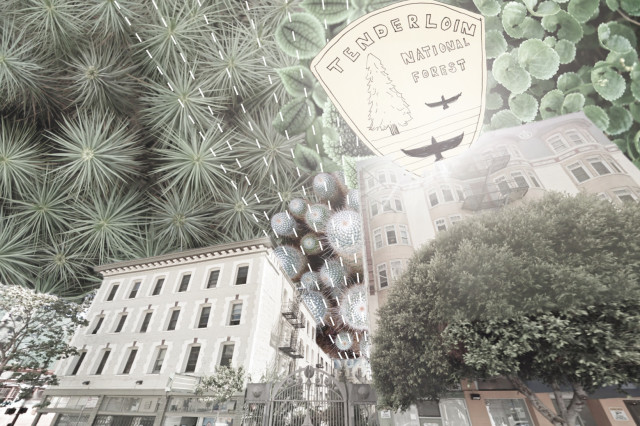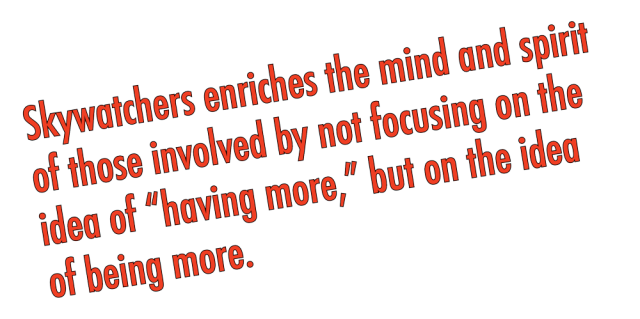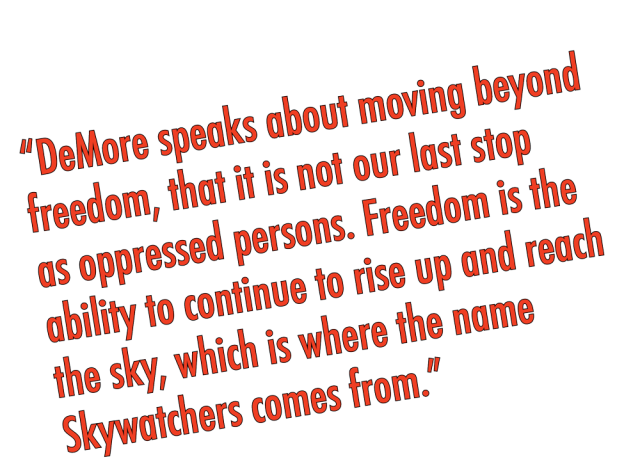Fall season of Skywatchers continues on Wednesday, November 12 with live music, dancing, and a photography exhibit at the Tenderloin National Forest.

If there is one thing the Tenderloin has more than any other neighborhood in San Francisco, it is heart. Walking through the streets, you would never expect to find a redwood, but tall trees and lush growth in planters line what used to be another dark and dreary alleyway. As an urban renewal project started by The Luggage Store, a local arts non-profit, this formerly dark corner is now the Tenderloin National Forest.
There, amid the green, you can find the rhythmic beating of drums and interpretive dance brought to the TL by ABD Productions‘ ongoing project, Skywatchers. Anne Bluthenthal and Dancers and their community partners have dedicated themselves to providing a space for people in the Tenderloin to find both themselves and a sense of community through participatory, free-form performance. Skywatchers turns this small sector of the Tenderloin into a dazzling communal space for artistic expression.
Unfortunately, the Tenderloin is continually regarded as a neighborhood not worth caring about by middle-class citizens and local politicians because of its long history of violence, drug abuse, and sex work. However, the politically expedient narrative that TL is ridden by crime erases the neighborhood’s vibrant cultural life, and attention on so-called criminals frequently overlooks its low-income seniors, families, disabled persons, and transients. In an effort to generate exposure for the vivacious energy hunkered down in the TL, Skywatchers worked closely with two single-room occupancy (SRO) hotels bordering the Tenderloin National Forest, The Senator and Cambridge Hotel, to connect residents with one another and further explore their creative potentials.
Participants, dubbed “co-creators,” of Skywatchers express having been treated or thought of as less than human because somehow being in a low-income neighborhood has transformed them into untouchables, damaged goods. Since most members of Skywatchers reside in an impoverished neighborhood, they are thought of as subpar to the wealthier, more ‘refined’ population of San Francisco. Brazilian activist, Paulo Freire, explains the economic piece of this logic in Pedagogy of the Oppressed, saying that “if others do not have more, it is because they are incompetent and lazy,” (59) revealing much of the way people choose to think about those in poverty. The movement of new money into a low-income neighborhood pressures law enforcement to ‘clean up’ the streets and contribute to the displacement of impoverished or otherwise oppressed persons. Skywatchers’ hand in combating such displacement is to create bonds between residents of the Tenderloin and encourage resourcefulness amongst their co-creators so they can look to each other for help, support, and all the other forms of nourishment a community can provide, despite the economic and social pressure generated by gentrification.
Skywatchers enriches the mind and spirit of those involved by not focusing on the idea of “having more,” but on the idea of being more. Through various activities Skywatchers has shown how the use of creative expression can be liberating by encouraging the co-creators to experience fulfillment by engaging with the people around them and the environments they’re in. This constant collaboration is inspired through song, dance, spoken word, and everything in between.
While Skywatchers doesn’t directly involve itself with the gentrification happening in the Tenderloin, it does pull together the members of the community to work together and create agency for themselves and others through the bountiful beauty of song and art. When the impoverished neighborhood was “first tagged with the name “Tenderloin” … [it was] because of its similarity to a New York neighborhood that was regarded as a choice assignment for corrupt cops.” Its history of being easy prey for systematic control makes projects like Skywatchers imperative to neighborhoods like the TL where voice is needed. By providing both a space and foundation for building community, Skywatchers makes residents of the TL a smaller target for the exclusionary nature of gentrification. They are able to engage and become a part of their environment instead of being resigned to becoming a product of circumstance.
For Charles Pitts, a co-creator of Skywatchers, it was important to engage with his surroundings. When he first drifted into San Francisco, Pitts came with “eighty dollars and a duffle bag full of poetry” and banked on making life work out here. As a poet, Pitts favored the power of words and did not let his poverty hinder his need to be active in his community, describing himself as the type to “run around with a copy of the Constitution.” Skywatchers provided him and others with community and healing. By providing a space for creative expression to manifest and flourish, Skywatchers solidifies the voices of people like Pitts and inspires them speak louder against an uneducated government that doesn’t understand poverty.
In a spontaneously composed group song led by Skywatchers’ featured artist sings about freedom and creativity as “free following” entities and Skywatchers follows this flexibility to a tee. Although it is easy for an organization to come into a neighborhood with a plan for change, Skywatchers listens to the community and allows their wants and needs to direct the development of the piece. Through co-creation, Skywatchers’ participants gain creative control over the content of the events. This encourages the ability to express themselves and let their art be their activism, tranquility, and involvement with their environment.
In light of the recent gentrification happening in San Francisco, including the TL specifically, the neighborhood has shrunk considerably as police herd crime into other less techie populated pastures. In the seventies, the TL’s “nighttime population swelled with thrill seekers from throughout the Bay Area who came to the neighborhood to walk on the wild side and taste its illicit pleasures,” and like much of the new money moving into the neighborhood, techies and middle class art students exploit the stereotypes of the TL to brandish their badge of courage for having braved the freakshow. And while the neighborhood is rough around the edges, many of the people living in the TL consider it home. Even the organizers and organizations involved with Skywatchers consider the Tenderloin home and residents of the neighborhood to be family.
Standing just outside of the Tenderloin National Forest, I spoke with Yanina Rivera, project manager of Skywatchers, whose familiar face received many hello’s from the locals in the area. In all her time with Skywatchers, she had never considered her acts of kindness as extraneous, but as something she would do for friends.
As night descended on their performance, the smiles and laughter shared in song, dance, and conversation unmasked a different face of the Tenderloin: one of joy. DeMore took this opportunity to pose a question to the audience, “What is freedom?” Charles Pitts, dressed rather eccentrically in bright reds and a woven hat shouts, “A dance to victory!” and so a song begins. With more input from the audience, DeMore strings together a melody that couldn’t exist without audience engagement.
All these ideas reflect some of what the Skywatchers community values and brings to light: a people interested creating opportunity for both themselves and others. Pitts believes that “[people] don’t understand what they have . . . It’s not about the money. It’s about ideas and philosophies.” And plenty of these are shared and valued at Skywatchers’ event. By building community amongst one another, Pitts and other TL residents whom Skywatchers brings together are able to recognize the strengths in each other to create support, friendship, and exchange skills.
Through equal parts community support and appreciation for individuality, Silver Sonic, who is usually decked out in silver body paint, describes being “opened up to my creativity” by attending Skywatchers. As a musician, Sonic feels “my main instrument is my voice,” and though Sonic may use a brush or drums, the instruments all communicate with one another. Skywatchers exposes people to those different modes of communication. Though performance may not be one’s expertise or even cup of tea, attendees are encouraged to listen, hear it out, find out what works for them.
DeMore speaks about moving beyond freedom, that it is not our last stop as oppressed persons. Freedom is the ability to continue to rise up and reach the sky, which the name Skywatchers alludes to. Like a child gazing at the blue expanse before her, DeMore asks us all to raise our arms, feel the weightlessness and follow it, up. And though you can’t see a damned star in the city of San Francisco, I saw hope, possibility, and all the other words used to describe freedom that night.
While city hall has its ideas of a type of people that should be living in the TL, many forget that its people are just that, people. And as DeMore closes the singing circle with a rendition of “This Little Light of Mine,” the voices of Pitts, Sonic, Rivera, and the artistic fervor teeming within the Skywatchers family continues to echo out into the Tenderloin.
